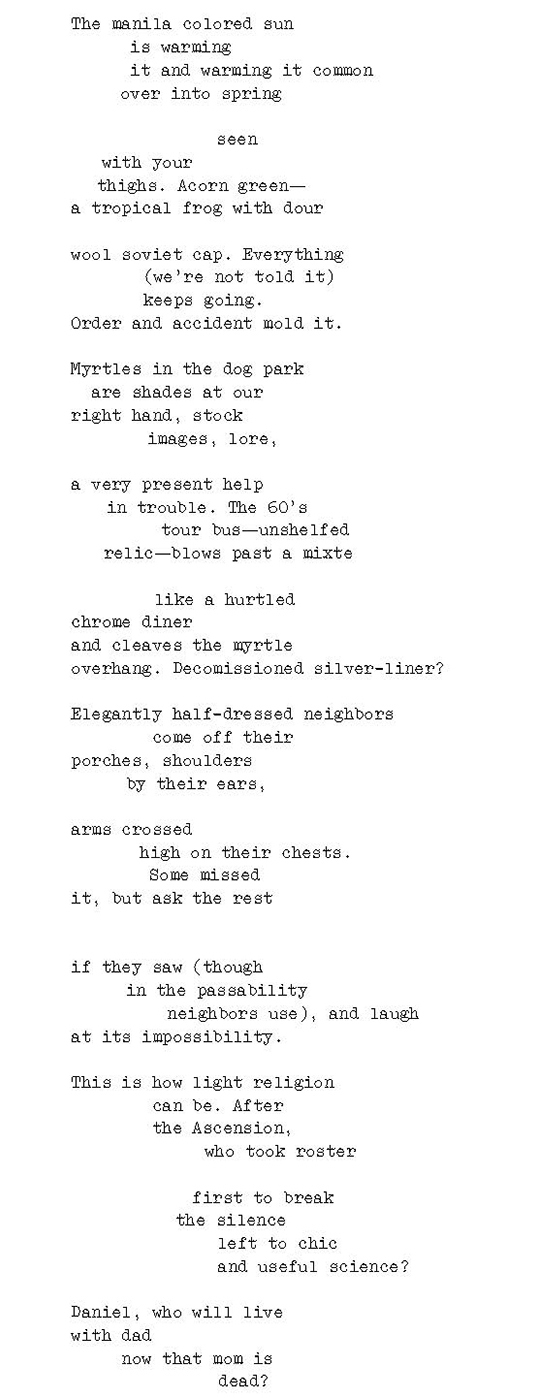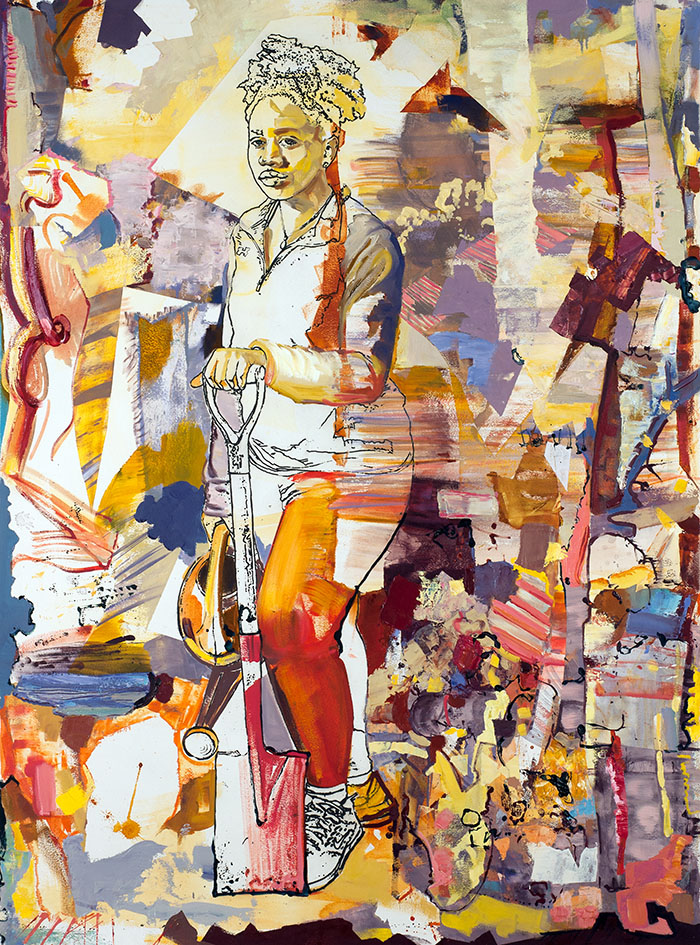
Page Laughlin, Harold W. Tribble Professor, Painting
Artist’s Statement: The Labor Series is one series from my Coloring Book Portfolio, an ongoing set of art projects that move between studio practice and community engagement projects. For the Labor Series, I work with the mediums of painting, photography and digital drawing in order to generate imagery for relatively large oil paintings on paper. The line drawing I develop digitally for the paintings references a coloring book, a surface design eliciting the conflict between free agency and external control — a template for “coloring” inside and outside “the lines.”
The Labor Series creates and explores images of contemporary women engaged in simple tasks of hand labor. I am interested in how we are defined by and through the ‘things we carry’ — the physical, psychological and social markers of who we are. I portray young women in young adulthood, when we shift from being carried to having to carry. I am interested in the distance between what we pick up and what we must accomplish.
The Collaborations
(Jump to collaboration by clicking professors)
- “Digging” by L. Lamar Wilson
- Accompanying art by David Finn
- “When the Audience Tired, Little Richard Would Scold, ‘The Beauty is Still on Duty'” by Erik Ekstrand (’07)
- Accompanying art by Paul Bright
- “Notes on the Enclosure of Notes” by Amy Catanzano
- Accompanying art by Leigh Ann Hallberg
- “Roots” by Elisabeth Whitehead
- Accompanying art by Joel Tauber
Digging
By L. Lamar Wilson
Plant some s--! the Gangsta Gardener’s Broken sink orders. Cordoned outside This fence, I cannot tell if a daffodil Or spent honeycomb glares back, but surely, It’s gone & long forgotten to every eye But mine. Defiant, I nab a too-green lime From the sidewalk, hide my bulbous skull Behind a fiery frond withering in the middle Of the block. Castaway, too, I lie again, feign I can bring a dying thing back, keep digging & hoping I’ll plumb the sophic root, here In south-central LA. Every day, we scale This barrier reef of chained links & lap The daisies I imagine doing backstrokes In what was once a pool, bring compost & water, keep digging & hoping to play God, call back from certain extinction Some living thing we assume we’ll always have To waste, because you said we must. Here I stand, my one good hand holding all I can salvage, believing I’ll be born again In another black man’s big, warm hands. I wanna be your daisy may, gangsta boo. Grow a baby bird or three inside, sugarplum. A honeycreeper or giant mountain lobelia, Some coral, any doomed thing you want.
AUTHOR BIO: Assistant Professor of English L. Lamar Wilson taught creative writing and literature at Wake Forest from 2019-2020. His documentary poetics has been featured in two poetry collections, a stage production and a film: “Sacrilegion” (Carolina Wren Press, 2013); “Prime” (Sibling Rivalry Press, 2014); “The Gospel Truth” (2017); and “The Changing Same” (PBS/POV Shorts, 2019), a collaboration with Rada Film Group. “Digging” first appeared in The New York Times and remains online at nyti.ms/37D0BQF
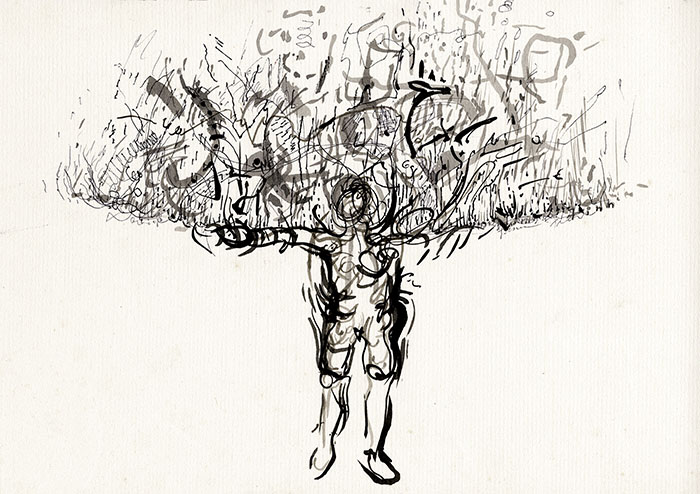
ARTIST BIO: David Finn has had more than 15 solo exhibitions and is the recipient of fellowship grants from the Bemis Foundation, New York Foundation for the Arts, North Carolina Arts Council and the National Endowment for the Arts. With an abiding focus on public art, he currently works with the project “Shadow Citizens” (on Instagram). Finn is an art professor and chair of the Department of Art, where he has taught sculpture since 1987.
When the Audience Tired, Little Richard would scold, “The beauty is still on duty.”
By Eric Ekstrand (’07)
AUTHOR BIO: Associate Teaching Professor Eric Ekstrand (’07), author of “Laodicea” (Omnidawn, 2015), teaches first year writing and creative writing. Both his father and grandfather taught at the University’s medical school, and he lives with his husband, Danny. The poem first appeared in EcoTheoReview in 2015.
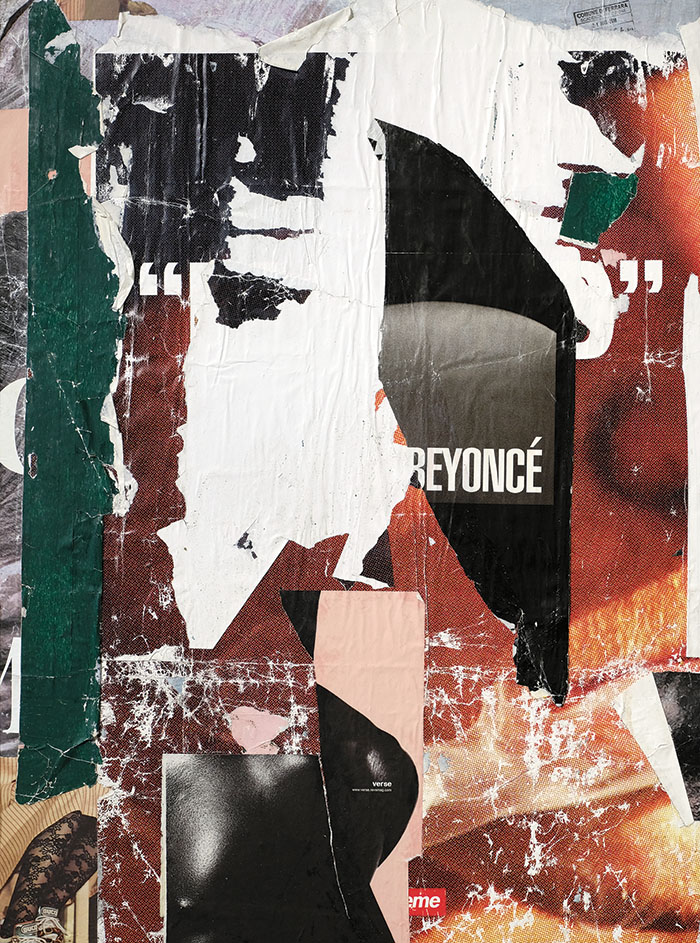
ABOUT THE ARTIST: Paul Bright is the director of the Charlotte and Philip Hanes Art Gallery at Wake Forest. An artist known for his paper collages and sound collages — while most of us take pictures, he says, "I 'take' sounds" — he has exhibited his work in the United States, England, Germany, Italy, Canada and Switzerland.
Notes on the Enclosure of Notes
by Amy Catanzano
We were free like fixed stars. They fall beneath me. I do not move; we are free to clear the space with these stars. Space clears the stars from my eyes. They are moving, and we are free to fix the stars. They move without falling. We are falling and free. We are free to make a spell with the stars. Space is free; I populate the space with stars. We fall beneath them like the sea. We clear the sea of its space. We are free; the sea is free. The sea is fixed. The sea has moved; I am fixed by the falling stars. We clear the space from our eyes so that all we see are the stars. The sea moves. It is populated with words; the sea falls like a star. We are free to clear the words from our eyes. They do not move. Words are not fixed stars. I am free in the sea. I am free like the words falling; nothing is fixed. We populate the words in our eyes with stars; we fall with them in space up from the sea, free.
AUTHOR BIO: Associate Professor of English Amy Catanzano is the author of three books and is known for exploring poetry in parallel to physics and cosmology. Catanzano’s second book, “Multiversal” (Fordham University Press, 2009), in which this poem appeared, received the PEN Center USA Literary Award in Poetry. She is also Poet-in-Residence.
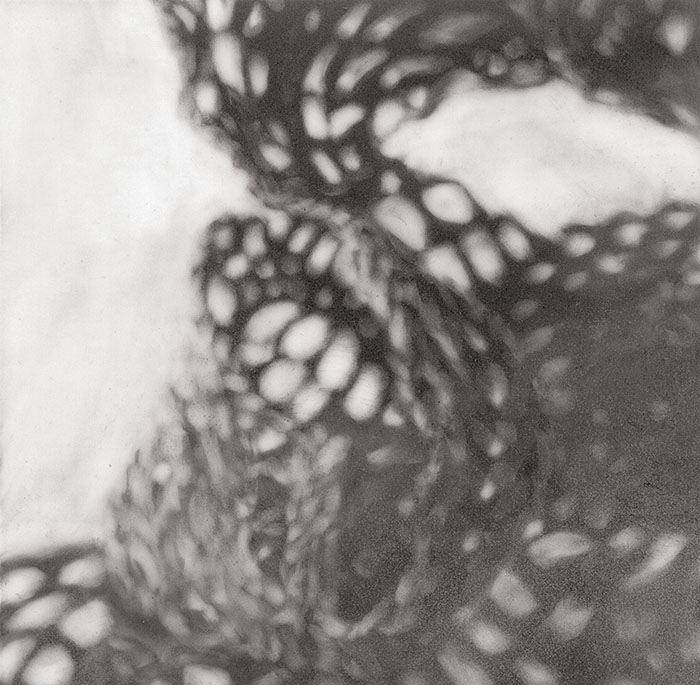
“Somatic Memory #22,” graphite on Mylar, by Leigh Ann Hallberg<br /> <br /> ARTIST BIO: Leigh Ann Hallberg teaches drawing at Wake Forest, where she is a teaching professor of art. Her artwork centers around her interest in human perception and our sense of space, semi-permeable membranes and the passage of time.
‘Roots’
by Elisabeth Whitehead
there is a box inside the body where the torso should be / inside are gears that curve like hair (or grasses) pliant as though moved by storms of blackwater (inside / also are insects that sway) / remove the box to see to the landscape behind: in roots attending, cleft earth, clear rain, a section of sky dug out and obscuring / where the wounds went through and just kept going / through sun and through moon / spherical wounds / that rotate like a wheel / the sun pitted, as the moon brittle / that all possibilities can be seen is our only constancy / or hope in / warding off evil, cures for blistering, stings, whisperings, protecting / the sound of a heart in an egg, in my hand, there is a box / like a dividing line of skin / a spine that unrolls like a scroll / Buddhism which says, the mind is a waterfall, and / stand behind the waterfall/ that is as black as the night / that breathes in my own breath
AUTHOR BIO: Associate Teaching Professor Elisabeth Whitehead teaches writing seminars and poetry workshops at Wake Forest. She is the author of two chapbooks, “A Pilgrim’s Traveling Kit” (Cosa Nostra Editions, 2008) and “To the Solar North” (Instance Press, 2014).
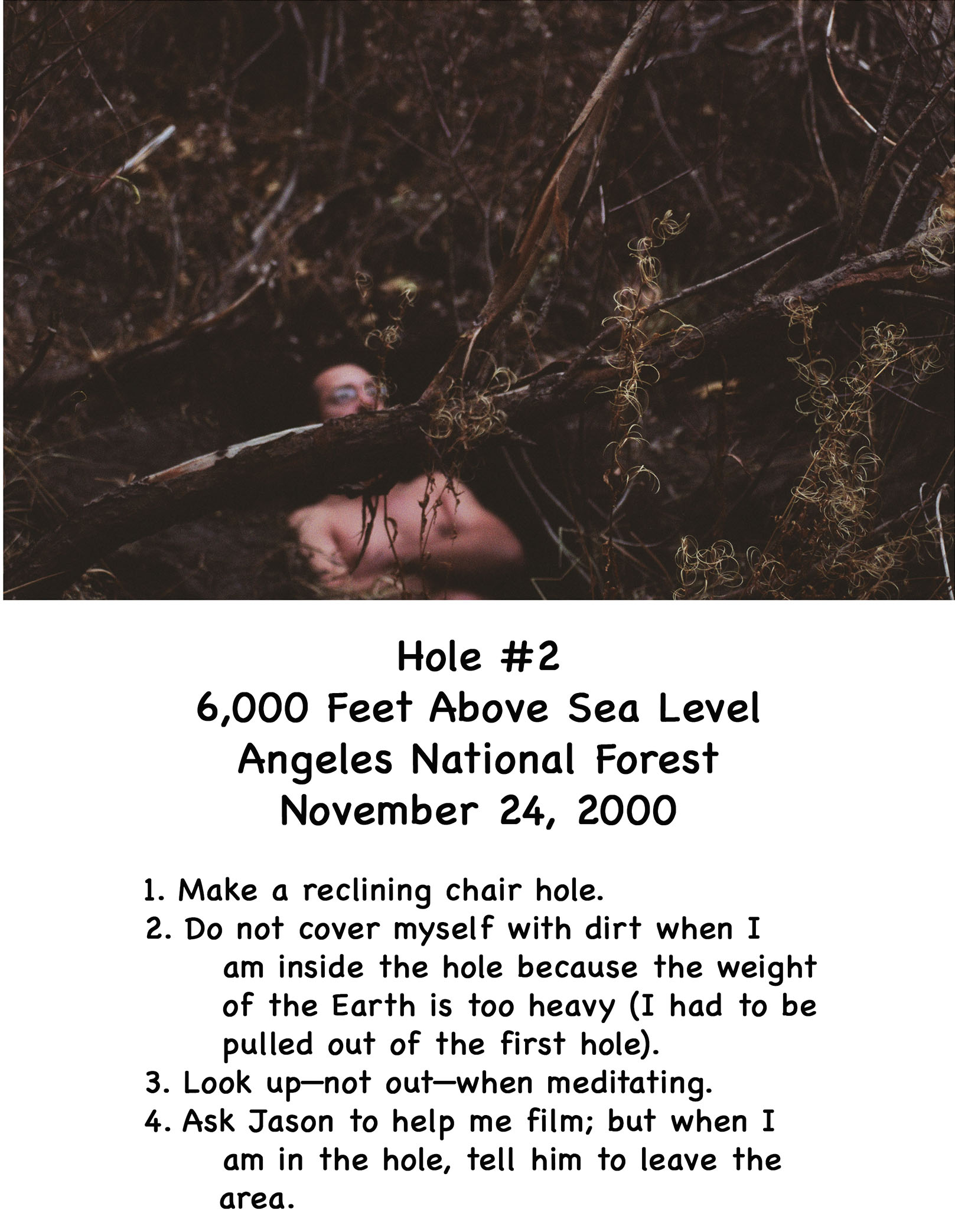
<a name="elisabeth"></a><br /> “Hole #2”, from the seven-channel video installation and photo/text series “Seven Attempts To Make A Ritual” by Joel Tauber.<br /> <br /> ARTIST BIO: Activist. Artist. Filmmaker. Dreamer of a world guided by ethics and environmentalism. Associate Professor of Art Joel Tauber sparks discourse and facilitates change via direct actions and interventions, video installations, films, photographs, public art, podcasts and written stories. THE above image, “Hole #2,” is from the seven-channel video installation and photo/text series “Seven Attempts To Make A Ritual” See “Seven Attempts to Make A Ritual” at <a href="http://nyti.ms/37D0BQF">joeltauber.com/holes</a>
